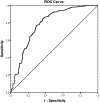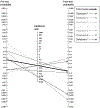Diffusion-weighted Imaging Allows for Downgrading MR BI-RADS 4 Lesions in Contrast-enhanced MRI of the Breast to Avoid Unnecessary Biopsy
- PMID: 33446565
- PMCID: PMC8406278
- DOI: 10.1158/1078-0432.CCR-20-3037
Diffusion-weighted Imaging Allows for Downgrading MR BI-RADS 4 Lesions in Contrast-enhanced MRI of the Breast to Avoid Unnecessary Biopsy
Abstract
Purpose: Diffusion-weighted imaging with the calculation of an apparent diffusion coefficient (ADC) has been proposed as a quantitative biomarker on contrast-enhanced MRI (CE-MRI) of the breast. There is a need to approve a generalizable ADC cutoff. The purpose of this study was to evaluate whether a predefined ADC cutoff allows downgrading of BI-RADS 4 lesions on CE-MRI, avoiding unnecessary biopsies.
Experimental design: This was a retrospective, multicentric, cross-sectional study. Data from five centers were pooled on the individual lesion level. Eligible patients had a BI-RADS 4 rating on CE-MRI. For each center, two breast radiologists evaluated the images. Data on lesion morphology (mass, non-mass), size, and ADC were collected. Histology was the standard of reference. A previously suggested ADC cutoff (≥1.5 × 10-3 mm2/second) was applied. A negative likelihood ratio of 0.1 or lower was considered as a rule-out criterion for breast cancer. Diagnostic performance indices were calculated by ROC analysis.
Results: There were 657 female patients (mean age, 42; SD, 14.1) with 696 BI-RADS 4 lesions included. Disease prevalence was 59.5% (414/696). The area under the ROC curve was 0.784. Applying the investigated ADC cutoff, sensitivity was 96.6% (400/414). The potential reduction of unnecessary biopsies was 32.6% (92/282).
Conclusions: An ADC cutoff of ≥1.5 × 10-3 mm2/second allows downgrading of lesions classified as BI-RADS 4 on breast CE-MRI. One-third of unnecessary biopsies could thus be avoided.
©2021 American Association for Cancer Research.
Conflict of interest statement
Clauser P. received speaker’s fee from Siemens Healthcare GmBH.
The other authors declare no potential conflict of interest.
Figures



Similar articles
-
Combining a breast apparent diffusion coefficient category system with Breast Imaging Reporting and Data System assessment improves specificity of breast lesions diagnosis.Br J Radiol. 2025 Jul 1;98(1171):1080-1089. doi: 10.1093/bjr/tqaf084. Br J Radiol. 2025. PMID: 40268740
-
Combining b2500 diffusion-weighted imaging with BI-RADS improves the specificity of breast MRI.Diagn Interv Imaging. 2023 Sep;104(9):410-418. doi: 10.1016/j.diii.2023.05.001. Epub 2023 May 18. Diagn Interv Imaging. 2023. PMID: 37208291
-
MRI-only lesions: application of diffusion-weighted imaging obviates unnecessary MR-guided breast biopsies.Eur Radiol. 2014 Jun;24(6):1204-10. doi: 10.1007/s00330-014-3153-6. Epub 2014 Apr 5. Eur Radiol. 2014. PMID: 24706105
-
Can structured integration of BI-RADS criteria by a clinical decision rule reduce the number of unnecessary biopsies in BI-RADS 4 lesions? A systematic review and meta-analysis.Eur Radiol. 2025 Mar;35(3):1504-1513. doi: 10.1007/s00330-024-11274-6. Epub 2024 Dec 18. Eur Radiol. 2025. PMID: 39694886 Free PMC article.
-
Improved Differential Diagnosis Based on BI-RADS Descriptors and Apparent Diffusion Coefficient for Breast Lesions: A Multiparametric MRI Analysis as Compared to Kaiser Score.Acad Radiol. 2023 Sep;30 Suppl 2:S93-S103. doi: 10.1016/j.acra.2023.03.035. Epub 2023 May 24. Acad Radiol. 2023. PMID: 37236897 Review.
Cited by
-
A survey by the European Society of Breast Imaging on the implementation of breast diffusion-weighted imaging in clinical practice.Eur Radiol. 2022 Oct;32(10):6588-6597. doi: 10.1007/s00330-022-08833-0. Epub 2022 May 4. Eur Radiol. 2022. PMID: 35507050 Free PMC article.
-
Differentiation of Benign and Malignant Breast Lesions Using ADC Values and ADC Ratio in Breast MRI.Diagnostics (Basel). 2022 Jan 27;12(2):332. doi: 10.3390/diagnostics12020332. Diagnostics (Basel). 2022. PMID: 35204423 Free PMC article.
-
A Comparative Assessment of MR BI-RADS 4 Breast Lesions With Kaiser Score and Apparent Diffusion Coefficient Value.Front Oncol. 2021 Dec 2;11:779642. doi: 10.3389/fonc.2021.779642. eCollection 2021. Front Oncol. 2021. PMID: 34926290 Free PMC article.
-
Diffusion weighted imaging for improving the diagnostic performance of screening breast MRI: impact of apparent diffusion coefficient quantitation methods and cutoffs.Front Oncol. 2024 Dec 20;14:1437506. doi: 10.3389/fonc.2024.1437506. eCollection 2024. Front Oncol. 2024. PMID: 39759131 Free PMC article.
-
Comparison of the effectiveness of contrast-enhanced mammography in detecting malignant lesions in patients with extremely dense breasts compared to the all-densities population.Pol J Radiol. 2024 May 15;89:e240-e248. doi: 10.5114/pjr/186180. eCollection 2024. Pol J Radiol. 2024. PMID: 38938658 Free PMC article.
References
-
- Bakker MF, de Lange SV, Pijnappel RM, et al.Supplemental MRI Screening for Women with Extremely Dense Breast Tissue. N Engl J Med. 2019;381(22):2091–2102. - PubMed
-
- Amitai Y, Scaranelo A, Menes TS, et al.Can breast MRI accurately exclude malignancy in mammographic architectural distortion? Eur Radiol. 2020;30(5):2751–2760. - PubMed
-
- Niell BL, Bhatt K, Dang P, Humphrey K. Utility of Breast MRI for Further Evaluation of Equivocal Findings on Digital Breast Tomosynthesis. AJR Am J Roentgenol. 2018;211(5):1171–1178. - PubMed
Publication types
MeSH terms
Substances
Grants and funding
LinkOut - more resources
Full Text Sources
Other Literature Sources
Medical

